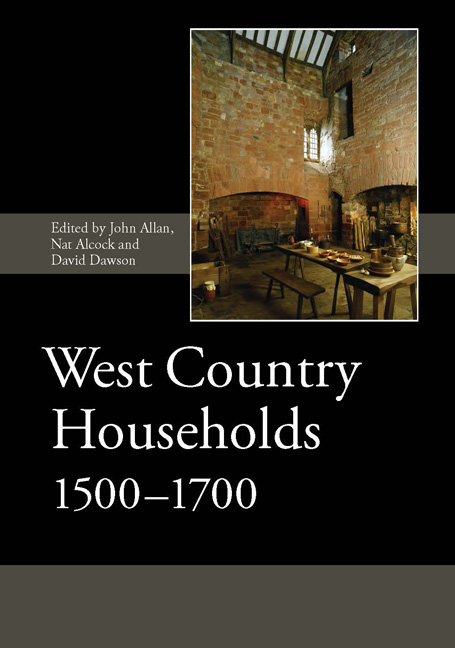Book contents
- Frontmatter
- Dedication
- Contents
- List of Illustrations
- List of Contributors
- List of Abbreviations
- Introduction
- I The Form and Development of West Country Houses
- II The Decoration of West Country Houses
- III The Material Culture of West Country Households
- 10 Culinary Artefacts in West Country Households, 1550–1700: Form, Function and Nomenclature
- 11 The Archaeology of the West Country Bronze Foundries
- 12 Cast Bronze Cooking Pots in England, 1500–1720
- 13 Table Glass in the West Country Home, c. 1500–1700
- 14 Portuguese Faience in South-West England
- 15 Dinner on the Ceiling: the 17th-Century Plasterwork at 144 Fore Street, Exeter
- 16 Pots and Texts: Understanding Pots in Use
- 17 Presenting an Elizabethan Interior: the Reinterpretation of St Nicholas Priory, Exeter
- Index of People and Places
- Index of Subjects
10 - Culinary Artefacts in West Country Households, 1550–1700: Form, Function and Nomenclature
from III - The Material Culture of West Country Households
Published online by Cambridge University Press: 05 May 2015
- Frontmatter
- Dedication
- Contents
- List of Illustrations
- List of Contributors
- List of Abbreviations
- Introduction
- I The Form and Development of West Country Houses
- II The Decoration of West Country Houses
- III The Material Culture of West Country Households
- 10 Culinary Artefacts in West Country Households, 1550–1700: Form, Function and Nomenclature
- 11 The Archaeology of the West Country Bronze Foundries
- 12 Cast Bronze Cooking Pots in England, 1500–1720
- 13 Table Glass in the West Country Home, c. 1500–1700
- 14 Portuguese Faience in South-West England
- 15 Dinner on the Ceiling: the 17th-Century Plasterwork at 144 Fore Street, Exeter
- 16 Pots and Texts: Understanding Pots in Use
- 17 Presenting an Elizabethan Interior: the Reinterpretation of St Nicholas Priory, Exeter
- Index of People and Places
- Index of Subjects
Summary
Using material and documentary evidence relating to early modern West Country households, this paper discusses the functions and original nomenclature relating to a range of household vessels represented in the archaeological and documentary record. It considers a number of foods and drinks which were specific to the West Country and the archaeological evidence for them. It argues that recovery of the names originally used for them helps to recreate accurately the human contexts in which they were used. By contrast, the widely accepted terminology developed in recent years by post-medieval archaeologists can actually confuse our understanding of the period.
INTRODUCTION
In the study of artefacts recovered from excavations, or surviving in public and private collections, the need to develop uniform names for groups of object with the same shape has been fundamental to the development of the subject. The practice has been to adopt names that are relatively modern introductions and bear no resemblance to those by which the objects were originally known. A classic example is the medieval ‘jug’. We know what the word means, but jugs are not referred to in any medieval source: the word ‘jug’ is first recorded only in the 1530s, when it appears to have been introduced. The more tightly modern terminology has been defined, the more remote it has become from the context in which the artefacts were used. To describe an ‘earthenware cauldron’ as a ‘jar’, for example, may fulfil the needs of a modern classification system, but as a means of furthering our understanding of past ways of life it is extremely misleading; first it implies that such vessels were called cauldrons, which they were not, and second, classifying them as jars suggests that they served in preserving foods, causing further confusion. Whilst not wishing to undervalue the benefits of modern and widely accepted classifications of form and function for post-medieval artefacts, this paper seeks to demonstrate the advantages of a different approach.
- Type
- Chapter
- Information
- West Country Households, 1500–1700 , pp. 255 - 270Publisher: Boydell & BrewerPrint publication year: 2015

